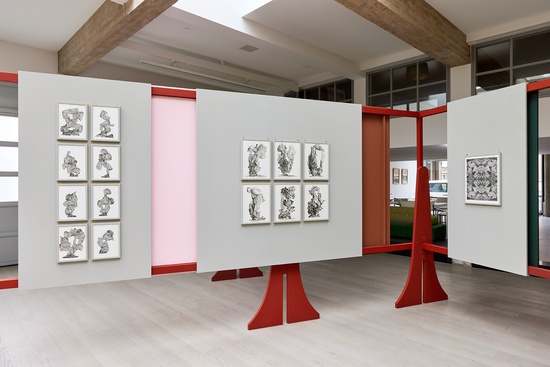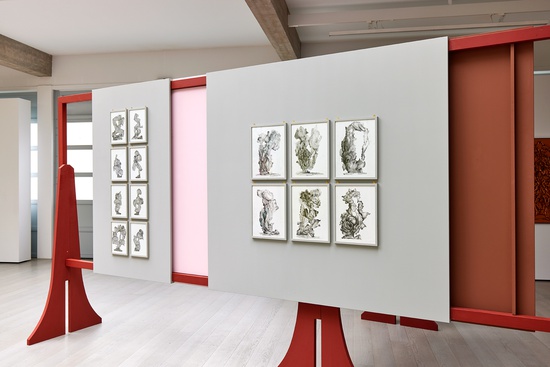15. Left: 8 x Argol collages
Ewoud van Rijn
(2020)
A four-sided structure sits at the heart of The Great Invocation; a freestanding build of scaffolding and wood panels, each painted a different colour and hung with a set of works by Ewoud Van Rijn. Two and a half years’ worth of prints, drawings and paintings come together in this installation, a single suite of work encompassing four waves of output. Hovering over them all, a mysterious figure: Kurt Seligmann, a lesser-known Surrealist, mystic and, for Van Rijn, an “artistic ancestor”. Seligmann has been at the centre of Van Rijn’s research practice for a number of years, an artistic obsession and line of enquiry that has spawned this expanding body of work.
Van Rijn’s art practice fuses painting, drawing and printmaking, using techniques of reproduction, doubling and mirroring to construct images. This process of building works through repetition is a meditative act, mirroring or mimicking the use of mantras and mudras (symbolic poses) in spiritual practice. For Van Rijn, this often incorporates a tracing method, taking body parts or details in isolation and then reconfiguring them into Frankenstein-ish conglomerations. A single component can be ‘dismembered’, abstracted and repeated into a composite, an unnerving arrangement of severed limbs and bodily vestiges.
In a series titled Nosferatu’s Mudra, the technique is used against deep, earthen grounds – clay red, terracotta orange. Long sinewy fingers extend outwards into an arachnid form, a knotted cluster of claws and pincers that threaten to poke, scrape, scratch and spike. Each ‘leg’ of this insect-like form is a mutated version of the same hand, its splindly finger and withered, talon-like nail whipping up a visceral sense of body horror. Contorted digits seem to wriggle and writhe, as if cognisant of their monstrosity. Their posture becomes a sort of mudra, frozen for eternity in a sinister yoga pose.
Elsewhere, in the Heritage of the Damned series, the mutants are beastly hybrids. Fluid forms in Indian ink and watercolour, these are linear renderings of grotesque figures: a cyclops head lashes an eel-like tongue. Ejecting from its head, totem-style, a grotesque woman with splayed breasts and eyes on protruding limbs, a single ear centre-brow. Again rinsed in tones of earthen brown, these nightmarish creatures seem to rise from the chthonic mud. Their precedent is in gnostic iconography: through the writings of a Victorian scholar, Van Rijn’s research led him to a gnostic ring with three faces, upon which this composite form is loosely based.
The Surrealists, of course, had an interest in the subconscious, in automatism (automatic drawing, writing), in the poetry of chance and the joy of composites (the ‘exquisite corpse’). Van Rijn’s techniques and approaches, then, find precedent in Surrealist work, but more than this, Van Rijn keeps alive the tradition of mysticism and occultism present in early Surrealist output, abandoned by the movement as it reached its ‘high’ phase. It’s this weirder, more occult, mystical branch of Surrealism, with roots in 19th-century Spiritualism, that Van Rijn invokes, and this is where Kurt Seligmann comes in.
Seligmann’s macabre, carnivalesque paintings and engravings are deeply influenced by his fascination with magic, occultism, alchemy and heraldry. As well as writing a canonical text on occultism (‘The Mirror of Magic’, 1948, still in print), he amassed a library of rare occult books, grimoires and treatises. Seligmann saw reconnecting with mythology and esoteric practices as a strategy for re-enchanting a world increasingly devoid of spiritualism. Van Rijn’s research into and engagement with Seligmann’s art practice creates a link between our present day challenges—technological overload, political instability, ideological battles—and the fragmented world of Seligmann and the Surrealists, operating in the tumultuous period before and after World War II. It begs the question of whether art, spiritualism and occult practices may once again present a path to reconnect with a larger reality beyond the distractions of technology, the media, and unending consumerism.
Perhaps the most direct reference to Seligmann here is a series titled ‘The Maldoror Militant’. In these works, intestinal forms squirm their way upwards; soft, lumpen shapes could be spinal cords or fat sacs, man or beast—and yet, their composition bears the remnants of heraldic motifs. Squint and you’ll see a man on horseback surrounded by cavalry; a single staff protruding upwards from the ground. Their fleshy, abstract but anthropomorphic forms jostle for victory against an earthy palette of sepia browns. Produced through eight layers of drypoint technique, they have a painterly use of ink that bestows them an organic quality. Van Rijn modelled the works after a Seligmann illustration he found in the Boijmans collection, in the 1938 edition of Breton’s ‘Les Chants de Maldoror’. The figure of the Maldoror is a wandering zombie, or walking dead, made even more gruesome and ghostly here in Van Rijn’s interpretation of this esoteric source material.
Alongside a longstanding interest in esoteric practices and neo-Pagan spiritualities, Van Rijn’s work is shot through with humour and low-brow references. Comic books, science fiction, fantasy and B-movies infiltrate his work alongside extensive research into art history and mythology. His research into Seligmann becomes more of a ghostly conversation or conjuring, a taking on of that artist’s mantle, channeling of his essence and spirit, unleashing the energy of a long-dead artistic ancestor or even father figure. Earthy, bodily and imbued with a sense of subconscious unease, these are works that go ‘against the grain’, that unlock otherworldly forces by digging down—backwards through the channels of time, through recomposing and reimagining, rearranging and repeating, unlocking untapped energy reserves of the distant past.
Text by Rosa Abbott



